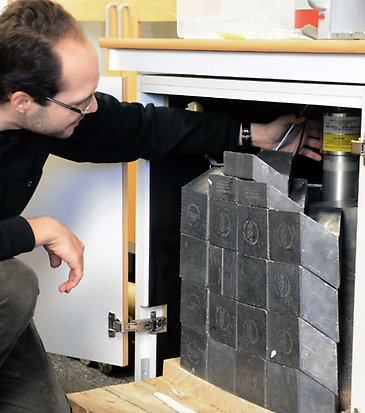The Nuclear Reactions Group

Ongoing Research within Nuclear Data
The group is active in the field of nuclear data research. We measure various observables for neutron-induced reactions and contribute to model development. Our aim is to improve the understanding of the influence of microscopic nuclear data on large scale systems. Examples are:
- dosimetry and fast neutron cancer therapy
- radiation effects in microelectronics
- nuclear power reactors, especially fast reactors within Generation IV.
This means in practice that we
- measure cross-sections for light-ion production and fission, as well as fragment mass distributions
- improve theoretical models describing nuclear reactions
- calculate parameters and their uncertainties for large systems such as fast reactors, in dependence of nuclear data.
This group is doing fundamental research about nuclear data and nuclear reactions. Knowledge about this is important for applications such as cancer treatments or transmutation of used nuclear fuel.
Our projects
Fission yield, i.e. the new nuclei created as fragments of a fission process, tells us a lot about what happens in the reaction itself. By measuring properties such as mass, energy, and emission angle, we learn more about what happens in the splitting of a nucleus. We also measure reaction cross sections for various nuclear reactions.
It is also important to understand uncertainties in nuclear reaction data, and how these uncertainties affect the result of simulations and calculations of realistic situations. We work with nuclear data libraries and nuclear model codes such as TALYS.
Learn more about our research projects by following the links to the right.
- Fission yield measurements
- Measurements at IGISOL
- Measurements of reaction cross sections using the Medley setup
- Nuclear data evaluation and uncertainty quantification
Past projects
Some things the group has worked with earlier.
The AVKOK project was a part of the thesis work of John Loberg, PhD. AVKOK is Avancerad Void-monitorering i KOKvattenreaktorer (Advanced void monitoring in boiling water reactors) and is covered in chapter 4 in John Loberg's doctoral thesis: Novel Diagnostics and Computational Methods of Neutron Fluxes in Boiling Water Reactors (2010).
A related project within the division, also using neutrons to detect the void fraction in boiling water reactors, is Studies of void distributions using neutron tomography.
The work of John Loberg is also part of the background to the project Core monitoring in lead-cooled fast reactors.
In the spring of 2013 we hosted the meeting Uncertainties in the fuel cycle. On the meeting archive page you can find the presentations from both of the days of the meeting.
Fission and Nuclear Power for Everyone
Nuclear fission releases large amounts of energy. This is taken advantage of in our nuclear power plants, which stand for a large amount of Sweden’s energy production. Part of our research at the Division of Applied Nuclear Physics is about making nuclear power even safer and more efficient.
Here you can watch Professor Stephan Pomp’s inaugural lecture from 2012, with the title Samhällstjänst för snabba neutroner: Kan använt kärnbränsle bli morgondagens energikälla? (in Swedish).
FILM med Stephan Pomp
Contact
- Programme Professor
- Stephan Pomp
- Head of Division
- Henrik Sjöstrand
